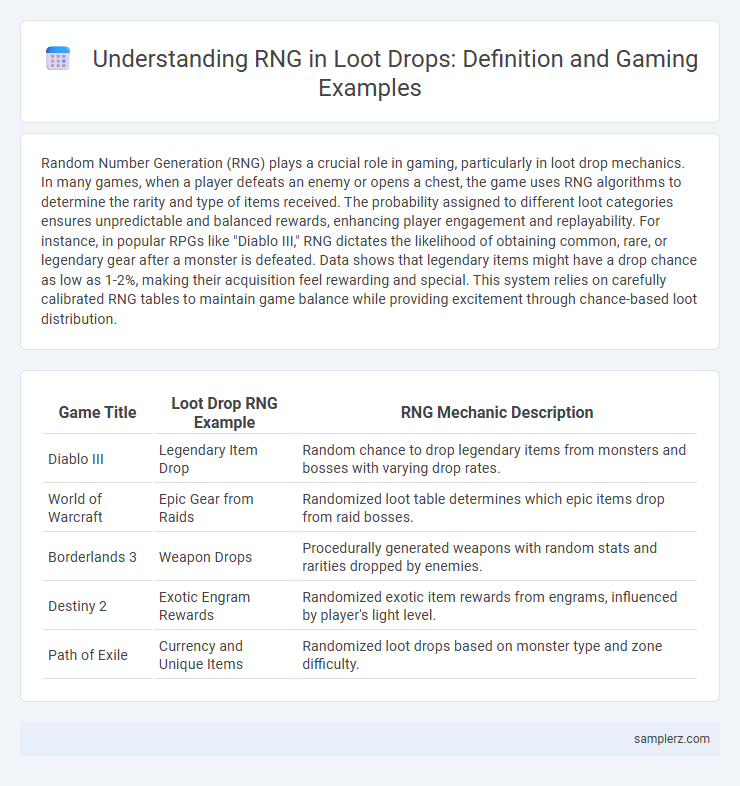Random Number Generation (RNG) plays a crucial role in gaming, particularly in loot drop mechanics. In many games, when a player defeats an enemy or opens a chest, the game uses RNG algorithms to determine the rarity and type of items received. The probability assigned to different loot categories ensures unpredictable and balanced rewards, enhancing player engagement and replayability. For instance, in popular RPGs like "Diablo III," RNG dictates the likelihood of obtaining common, rare, or legendary gear after a monster is defeated. Data shows that legendary items might have a drop chance as low as 1-2%, making their acquisition feel rewarding and special. This system relies on carefully calibrated RNG tables to maintain game balance while providing excitement through chance-based loot distribution.
Table of Comparison
| Game Title | Loot Drop RNG Example | RNG Mechanic Description |
|---|---|---|
| Diablo III | Legendary Item Drop | Random chance to drop legendary items from monsters and bosses with varying drop rates. |
| World of Warcraft | Epic Gear from Raids | Randomized loot table determines which epic items drop from raid bosses. |
| Borderlands 3 | Weapon Drops | Procedurally generated weapons with random stats and rarities dropped by enemies. |
| Destiny 2 | Exotic Engram Rewards | Randomized exotic item rewards from engrams, influenced by player's light level. |
| Path of Exile | Currency and Unique Items | Randomized loot drops based on monster type and zone difficulty. |
Understanding RNG in Loot Drop Systems
Random Number Generation (RNG) in loot drop systems determines the probability of obtaining specific items during gameplay, ensuring unpredictability and fairness. Games like "Diablo III" and "Borderlands" utilize RNG algorithms to assign drop rates, influencing player engagement and item rarity. Understanding RNG mechanics helps players optimize strategies for farming rare loot by recognizing patterns and probabilities embedded in the system.
How RNG Influences Loot Rarity
RNG (Random Number Generator) determines loot rarity by assigning probabilities to each item within the drop pool, ensuring that rare items have significantly lower chances of appearing compared to common ones. This system creates unpredictability in loot acquisition, incentivizing players to engage repeatedly for the possibility of high-value rewards. Game developers fine-tune RNG algorithms to balance player satisfaction and maintain long-term engagement through controlled rarity distribution.
Notable Games With RNG-Based Loot Drops
Games like Borderlands, Diablo III, and Destiny 2 utilize RNG-based loot drops to create unpredictable and exciting player rewards. In Borderlands, randomized weapon stats and rarity levels enhance replayability, while Diablo III's loot system employs RNG to generate diverse item affixes and legendary gear. Destiny 2's random roll weapons and armor drops encourage continuous gameplay with unique attribute combinations driven by RNG mechanics.
The Role of RNG in Gacha Mechanics
RNG (Random Number Generation) is fundamental in gacha mechanics, determining the probability of acquiring rare and valuable in-game items or characters. This system enhances player engagement by introducing unpredictability in loot drops, compelling players to continue play or invest to obtain desired rewards. The balance of RNG ensures fairness while driving monetization strategies in many popular mobile and online games.
Player Perceptions of RNG Fairness
Player perceptions of RNG fairness in loot drops often hinge on the transparency and consistency of random number generation algorithms. Games that clearly communicate drop rates and implement pseudorandom distribution systems tend to foster greater trust and satisfaction among players. Conversely, unpredictable or seemingly skewed RNG can lead to frustration, negatively impacting player retention and overall game experience.
RNG vs. Fixed Loot: A Comparison
Random Number Generation (RNG) in loot drops creates unpredictable rewards by assigning each item a specific drop probability, enhancing replayability and player engagement. Fixed loot systems guarantee predetermined rewards, ensuring consistent progression but potentially reducing excitement and variety. Comparing RNG and fixed loot highlights a balance between unpredictability for thrill and certainty for satisfaction in game design.
How Developers Balance RNG Loot
Developers balance RNG loot drops by implementing weighted probabilities that favor rare items without eliminating the chance of obtaining common rewards, ensuring player engagement and fairness. Dynamic drop rates adjust based on player progression or session length to prevent frustration and maintain excitement. This method combines algorithmic randomness with player-centric design, optimizing both unpredictability and satisfaction in gameplay.
Examples of Loot Boxes and RNG Elements
Loot boxes in games like Overwatch and Fortnite utilize RNG to determine the rarity and type of items players receive, creating unpredictability in loot drops. Titles such as Apex Legends incorporate RNG mechanics within their supply drops, where players can obtain weapons, skins, and other in-game resources with varying probabilities. The implementation of RNG in these systems enhances player engagement by offering random rewards, influencing gameplay strategies and player retention.
RNG and Its Impact on Progression
Random Number Generation (RNG) in loot drops critically influences player progression by determining the unpredictability and rarity of acquired items. This stochastic system can create significant variance in gameplay experience, where rare drops accelerate advancement while common items may prolong grinding. Consequently, RNG shapes game balance, player engagement, and pacing by controlling reward distribution and progression incentives.
Reducing RNG Frustration in Loot Drops
Implementing a pity timer system in loot drops ensures players receive high-value items after a set number of attempts, significantly reducing RNG frustration. Balancing drop rates with transparent probabilities increases player trust and satisfaction by clarifying the chances of obtaining rare rewards. Dynamic adjustments based on player engagement further mitigate RNG fatigue by tailoring loot outcomes to individual playstyles.

example of RNG in loot drop Infographic
 samplerz.com
samplerz.com